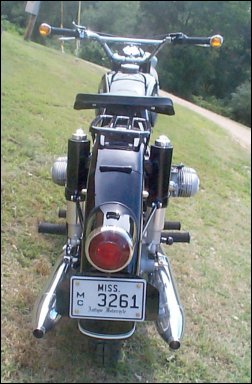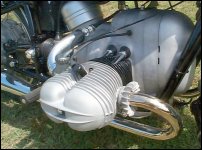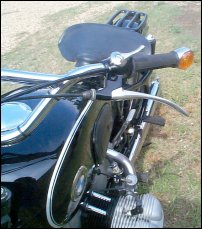
| Of all German machines, the undoubted leader in both technical design and detail finish is the BMW R69 which, being a 590cc o.h.v. twin is one of the few Continental designs which can provide a direct comparison with the many big British models. However, though the BMW may therefore be considered as probably the nearest equivalent to our popular 600 and 650cc vertical twins, several reservations should be entered. One is that it is designed as a luxury tourer, not as a sports machine. |  |
| Clutch action was smooth and sweet, the gear change (provided the rider's tactics were adapted to suit an engine-speed clutch) positive and easy. At first, the riding position gave signs of being just a little different from that to which a British rider would normally be accustomed. One is seated a little more to the rear (a result of the transverse engine). It took only a few miles, however, to become enthusiastic over the natural attitude provided by the BMW and it was with amazement that a tester normally finicky over control co-relationships discovered, after nearly 1,000 miles of riding, that the footrests were staggered by a couple of inches to suit the equivalent arrangement of the two big "pots." |  |
| Acceleration--though not
startling--was more than adequate for all practical purposes, the power
coming in smoothly, without a flat spot, all the way up the range. Once
the knack had been learned, quick gear changes could be made in either
direction. Steering was also first rate. Thanks to a low center of gravity, the R69 could be put into corners on any line the rider cared to choose, and it would hold to it tenaciously. It could be rapidly warped over from side to side, thanks in no small measure to an ideal riding position which enabled full knee pressure to be brought to bear, and was as handy as a lightweight when it came to maneuvering through traffic. |
 |
 |
With such attributes, it was not surprising that the tester came to regard it as an ideal machine for putting up averages. On one memorable morning, when Press schedules were tight and time short, the R69 conveyed a staffman from mid-Sussex to the New Forest and back between breakfast-time and lunch, with an hour or so's work thrown in! Over this tricky cross-country journey, measuring just over 90 miles on each stretch, the R69 responded nobly, doing what had to be done in the minimum time, but also with the maximum safety. Naturally, this required the best use to be made of the model's ability to cruise well up the scale, and it was frequently held with the needle at around the 90 mph mark, with occasional downhill sprints bringing it near the 100 mph. Under such conditions, fuel consumption naturally rose, but normally an overall 70 mpg could be expected on give-and-take going. |
| No small contribution to the R69 appeal was made by its excellent brakes. That at the front was of two-leading-shoe design. When the test figures were being carried out, the first two stops were both made in the allegedly "can't-be-done" distance of 26 feet, using the front brake alone! For fear of causing apoplexy amongst readers, attempts were thereupon discontinued. With both brakes in action, the best figure ever obtained in a Motor Cycling test (20 feet from a corrected 30 mph, the speed was 10% fast) was obtained in the two first tries. No more were made. |  The spark advance on the left handlebar is one of few characteristics that distinguish the R69 from other BMW twins manufactured between 1955 and 1968. |